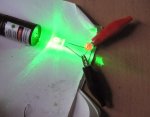Benm
0
- Joined
- Aug 16, 2007
- Messages
- 7,896
- Points
- 113
thejunkmonger said:I think the circuit would be much better if it was designed with 2 L.E.D's instead of one. One to capture the light and one to emit it.
That actually works when just putting them paralel - just a red and an orange high brightness 5mm led. Aim a green laser into the orange led and the red one will light up visibly.
The circuit above actually works btw, i just rigged it on a breadboard. The problem is that the flashes from the LED are so dim you cannon see them with the naked eye. I tried feeding it some current from 2 AA batteries and a 10k resistor, then it works like a charm. I can see the same thing happening electrically (on a scope) when i shine a laser into the LED, but its not bright enough to make out by eye.




